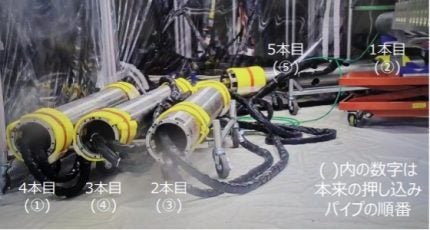
Tokyo Electric Power Company Holdings (TEPCO) said it has suspended its attempt to use a robot to remove a small amount of radioactive debris from unit 2 of the Fukushima Daiichi NPP, which suffered a reactor meltdown after the March 2011 earthquake and tsunami.
The demonstration project was stopped when workers noticed that five 1.5-metre pipes used to manoeuvre the robot had been placed in the wrong order and could not be corrected within the time limit for their radiation exposure. The pipes were to be used to push the robot through a penetration point in the primary containment vessel and pull it back when it finished. Once inside the vessel, the robot would be operated remotely from a safer location.
The workers had prepared the second push pipe for insertion instead of the first one while the push pipe that should have been in the first position was in the fourth position. The incorrect order of the pipes meant they could not be connected correctly.
The robot can extend up to about 22 metres to reach its target area where it would collect a fragment from the surface of the melted fuel mound using a gripper tool. The aim was to bring back less than 3 grams of an estimated 880 tonnes of highly radioactive molten fuel. The small sample will provide key data to develop future decommissioning methods and necessary technology and robots. Better understanding of the melted fuel debris is key to decommissioning the three wrecked reactors and the entire plant.
In Fukushima Daiichi units 1-3, the fuel and the metal cladding that formed the outer jacket of the fuel rods melted, then re-solidified as fuel debris during the reactor meltdowns. The aim is to begin fuel retrieval from unit 2 and to enlarge the scale of the operation. The retrieved fuel debris will be stored in the new storage facility that is to be constructed within the site.
The demonstration project was expected to last two weeks and TEPCO says a new start date has yet to be decided. TEPCO said: “We are currently investigating the cause of this incident. We will confirm and organise the necessary work, including the procedures, in the future.” TEPCO spokesperson Kenichi Takahara, referring to the pipe problem, said: “It seems to me a basic mistake,”. He added that officials are investigating, and the retrieval mission will resume only after they find the cause and have preventive measures in place “so a problem like this should never be repeated”.
TEPCO President Tomoaki Kobayakawa told reporters: “Debris removal is the most important task in the decommissioning process and must be done in a precise manner. Rather than cause a major problem by hurrying, it is important to proceed with the operation safely.”
Preparations for fuel removal from unit 2 had started in 2017 when a remotely operated camera on a telescopic probe took photos of the area directly below the pressure vessel – the pedestal. These showed a black mass and deposits near a grating in the pedestal area, which was thought to be melted fuel. TEPCO then sent in a scorpion-shaped robot, but it was unable to reach the pedestal. However, TEPCO said the information it gathered would help it with future decommissioning.
A suspended pan-tilt camera attached to a telescopic guiding pipe in 2018 was able to identify deposits and fuel assembly components at the bottom of the pedestal area. Work continued and a probe was able to pick up debris in five of the six areas that had been surveyed but no samples were removed.
An estimated total of 880 tons of debris remains inside the three reactors. The unit 2 reactor was selected for the trial debris extraction because it did not suffer a hydrogen explosion in the 2011 disaster and the extent of damage was less severe than at the other reactors.
When removed, the debris will be taken to the Japan Atomic Energy Agency’s Oarai Research and Development Institute in Ibaraki Prefecture to be carefully examined. Understanding the hardness of the debris will be relevant to the choice of equipment and methods for effectively extracting more of it. Also, determining its composition will advance efforts to determine safe storage methods.
“If even a few grams can be analysed, it’ll be possible to estimate the temperature inside the reactors at the time of the 2011 accident and other details,” said Yasuaki Miyamoto, director general of the agency’s Fukushima Research & Engineering Institute. “That should help to significantly accelerate decommissioning work.”
However, the spread and melting of the nuclear fuel differs in each reactor, so it remains unclear how useful an analysis of debris from the unit 2 reactor will be for reactors 1&3. In May and June, TEPCO completely examined about 1,000 operations related to the decommissioning, and finished reviewing the procedures for about 680 of them. However, debris extraction remains a problem.
Nagaoka University of Technology Professor. Hiroshi Yamagata, an expert on system safety engineering, says there is room for improvement. “Mistakes can be reduced by setting aside plenty of time to do this work, and by ensuring that the workers are properly educated and provided with sufficient information,” he said. “Decommissioning the reactors will be a long road.”






